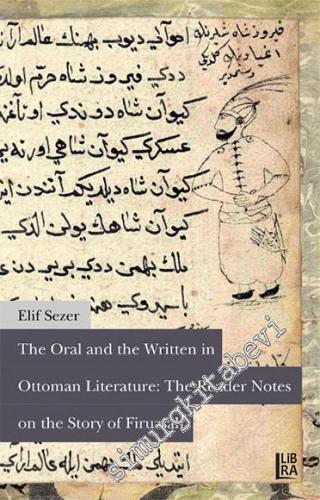#smrgKİTABEVİ The Oral and the Written in Ottoman Literature: The Reader Notes on the Story of Firuzşâh - 11

The manuscript under study, actually the forty-fifth volume of the entire story, contains many marginal notes. These notes give information about the names of the public readers, and the places and dates of the public readings. In addition, there are notes that show the daily, aesthetic, and even political reactions of the readers in the eighteenth century. Depending on these reactions, four types of readers were identified and named the romantic, the pedantic, the foul-mouthed and the Janissary. Focusing on the case of the Story of Fîrûzşâh, it has been shown that aspects of oral culture and their everyday expressions can also be traced from written texts.
İçindekiler
LIST OF FIGURES
ACKNOWLEDGEMENTS
NOTES ON TRANSCRIPTION
1. For the Transcription of the Manuscript (Appendix II)
2. For Quotes in the Body of the Book
CHAPTER 1
INTRODUCTION
Different Versions of the Fîrûzşâh Story
The Forty-Fifth Volume of Hikâye-i Fîrûzşâh
Reader and Reading Notes on the Manuscript
CHAPTER 2
A DISCUSSION ON THE 'ORAL ITY' AND 'LITERACY'
CHAPTER 3
THE ORAL AND THE WRITTEN IN OTTOMAN CULTURE
The Role of the Teacher in Oral Transmission
The Oral/Written Interface in Ottoman Literature
CHAPTER 4
THE ELISION OF THE STORY OF FÎRÛZŞÂH IN THE REPUBLICAN PERIOD
'Folk Literature' Studies in the Republican Era
The Reasons behind the Elision of the Story of Fîrûzşâh .
The Story of Fîrûzşâh at the Interface between the Oral and the Written
The Story of Fîrûzşâh between Center and Periphery during the Eighteenth Century
CHAPTER 5
THE PARATEX OF THE FÎRÛZŞÂH MANUSCRIPT
Performative Elements on the Manuscript
Reading Notes: Readers, Locales, and Audiences of the Manuscript
CHAPTER 6
READER TYPES:
PEDANTIC, ROMANTIC, FOUL-MOUTHED, AND JANISSARY
The Romantic Poet
The Janissary Abdi Efendi
The Foul-Mouthed
The Pedantic as another Voice in the Polyphony
CHAPTER 7
CONCLUSION
APPENDIX I
PHYSICAL PROPERTIES OF THE MANUSCRIPT
APPENDIX II
TRANSCRIPTION & FACSIMILE OF THE MANUSCRIPT
BIBLIOGRAPHY
INDEX
The manuscript under study, actually the forty-fifth volume of the entire story, contains many marginal notes. These notes give information about the names of the public readers, and the places and dates of the public readings. In addition, there are notes that show the daily, aesthetic, and even political reactions of the readers in the eighteenth century. Depending on these reactions, four types of readers were identified and named the romantic, the pedantic, the foul-mouthed and the Janissary. Focusing on the case of the Story of Fîrûzşâh, it has been shown that aspects of oral culture and their everyday expressions can also be traced from written texts.
İçindekiler
LIST OF FIGURES
ACKNOWLEDGEMENTS
NOTES ON TRANSCRIPTION
1. For the Transcription of the Manuscript (Appendix II)
2. For Quotes in the Body of the Book
CHAPTER 1
INTRODUCTION
Different Versions of the Fîrûzşâh Story
The Forty-Fifth Volume of Hikâye-i Fîrûzşâh
Reader and Reading Notes on the Manuscript
CHAPTER 2
A DISCUSSION ON THE 'ORAL ITY' AND 'LITERACY'
CHAPTER 3
THE ORAL AND THE WRITTEN IN OTTOMAN CULTURE
The Role of the Teacher in Oral Transmission
The Oral/Written Interface in Ottoman Literature
CHAPTER 4
THE ELISION OF THE STORY OF FÎRÛZŞÂH IN THE REPUBLICAN PERIOD
'Folk Literature' Studies in the Republican Era
The Reasons behind the Elision of the Story of Fîrûzşâh .
The Story of Fîrûzşâh at the Interface between the Oral and the Written
The Story of Fîrûzşâh between Center and Periphery during the Eighteenth Century
CHAPTER 5
THE PARATEX OF THE FÎRÛZŞÂH MANUSCRIPT
Performative Elements on the Manuscript
Reading Notes: Readers, Locales, and Audiences of the Manuscript
CHAPTER 6
READER TYPES:
PEDANTIC, ROMANTIC, FOUL-MOUTHED, AND JANISSARY
The Romantic Poet
The Janissary Abdi Efendi
The Foul-Mouthed
The Pedantic as another Voice in the Polyphony
CHAPTER 7
CONCLUSION
APPENDIX I
PHYSICAL PROPERTIES OF THE MANUSCRIPT
APPENDIX II
TRANSCRIPTION & FACSIMILE OF THE MANUSCRIPT
BIBLIOGRAPHY
INDEX





















